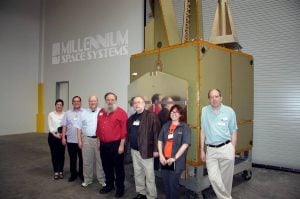
AMSAT is excited to announce that we have accepted an opportunity to participate in a potential rideshare as a hosted payload on a geosynchronous satellite planned for launch in 2017. An amateur radio payload, operating in the Amateur Satellite Service, will fly on a spacecraft which Millennium Space Systems (MSS) of El Segundo, CA is contracted to design, launch, and operate for the US government based on their Aquila M8 Series Satellite Structure.
A meeting to discuss this potential rideshare took place on April 13 at Millennium Space Systems that included Dr. Bob McGwier, N4HY; Sonya Rowe, KK4NLO; Franklin Antonio, N6NKF, co-founder of Qualcomm; Jerry Buxton, N0JY, AMSAT Vice President of Engineering and member of the board for AMSAT-NA; Dr. Tom Clark, K3IO, Director and President Emeritus of AMSAT-NA; Phil Karn, KA9Q; and Michelle Thompson, W5NYV.
Hosting the meeting for MSS were Stan Dubyn as founder and chairman of MSS, Vince Deno as president of MSS, Jeff Ward, K8KA, of MSS as VP for Product Development, formerly with SSTL and University of Surrey Space Center, and Ryan Lawrence of MSS as Project Manager on the spacecraft mission. Attending by telephone were Dr. Jonathan Black, Associate Research Director of Hume Center for Aerospace Systems and Associate Professor of Aerospace and Ocean Engineering and Dr. Michael Parker, KT7D, founder of RINCON Research Corp.
Following the meeting, Dr. Bob McGwier, N4HY, Director of Research at the Hume Center for National Security and Technology of Virginia Tech, and former director and former VP Engineering of AMSAT, described this as an opportunity to go forward with “AMSAT-Eagle” which, in the 2006-2008 timeframe, evolved into a microwave payload to be flown to geosynchonous orbit as a hosted payload. It would have provided digital communications to small terminals on the ground and a linear bent pipe transponder had it flown. This failed to go forward in part due to lack of an affordable flight opportunity.
McGwier outlined the next steps toward developing this mission:
1) To organize an effort at Virginia Tech to make a firm proposal to MSS and its US government sponsor, and organize an effort to raise sufficient funds to pay for development of the mission.
2) Enable Dr. Jonathan Black to lead the construction project at Virginia Tech in the Space@VT Center. Sonya Rowe, KK4NLO, Project Manager at the Hume Center will be the project manager.
3) Work for development of a low-cost microwave ground station for amateur radio still needs to be determined.
4) Dr. Michael Parker, KT7D, will solicit the cooperation of the Rincon Research Corp. for development of the software radio technology for this payload.
The AMSAT Board of Directors has accepted the invitation to participate in this potential rideshare payload opportunity. AMSAT expects to be involved in the development of the ground station and the payload RF development, and will serve as the amateur radio (hosted) payload operator once the satellite has been launched.
McGwier summarized, “The launch is currently scheduled for 2017 and the payload must be delivered for testing and integration by Spring of 2016. It is an ambitious schedule and all involved will have to gain and maintain a serious level of commitment to that which they agree to undertake.” AMSAT President, Barry Baines, WD4ASW, said, “The AMSAT leadership is excited to fly a Phase-IV geosynchonous amateur satellite payload. This is an evolving development as we collaborate with the VT Hume Center with a project that provides technical challenges to create a new amateur radio capability in space that will provide a variety of benefits not only for amateurs but also for emergency communications and STEM educational outreach.”
The transponder is expected to support a wide range of voice, digital, and experimental advanced communications technologies. A decision is expected soon specifying the microwave uplink and downlink bands.
Join and support AMSAT on this link!
Click here to download this page in PDF format for a handout at club meetings and hamfests.
